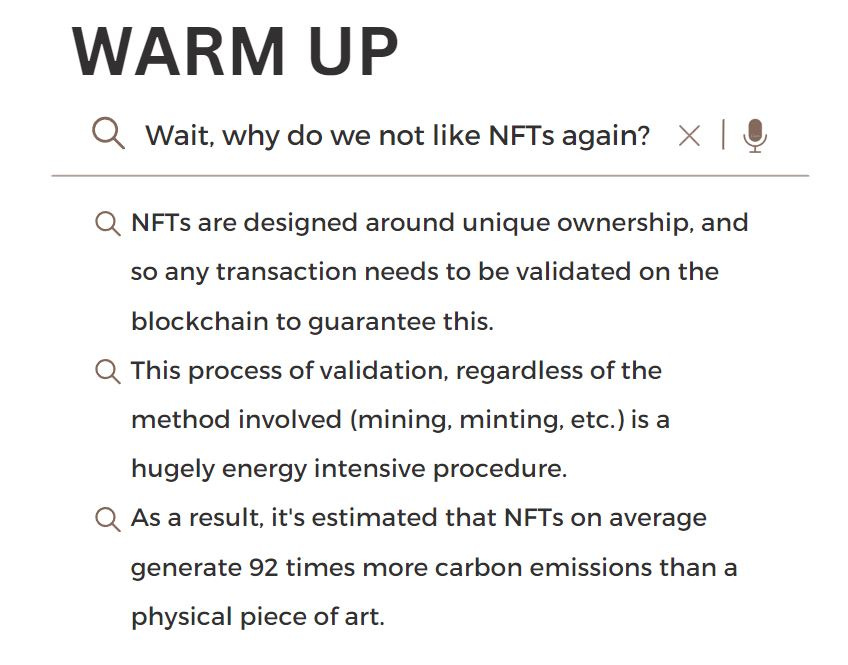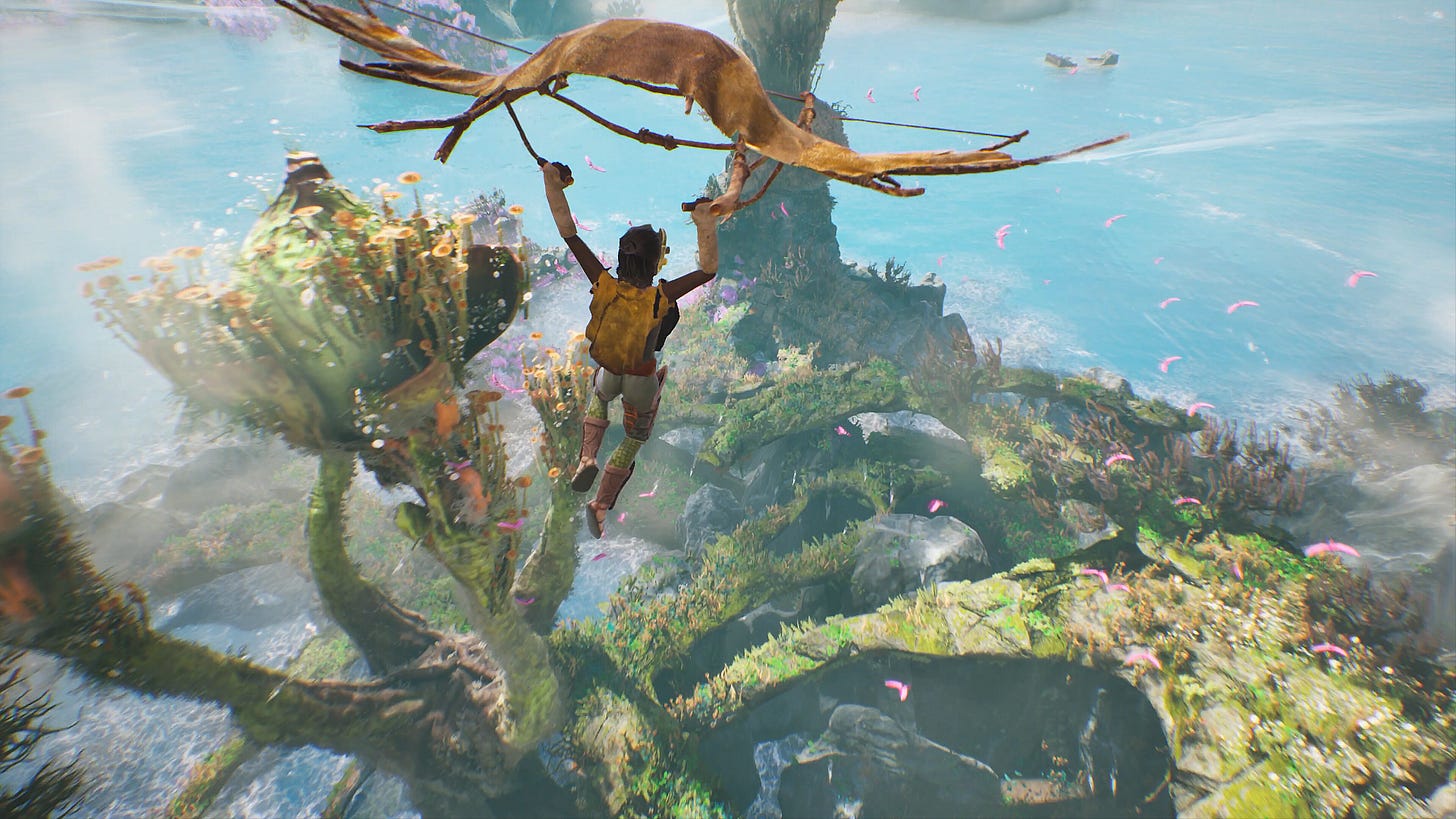A Link to the Present
Your latest digest of video game and climate change news from the past two weeks.
Welcome to the latest edition of Play Anthropocene!
Today is Tuesday, May 30, and we’re covering the latest developments in the world of video games and climate change. Happy reading!
The Legend of Zelda: Tears of the Kingdom sure has a lot of climate allegory
Much like the rest of civilisation, I’ve been playing through The Legend of Zelda: Tears of the Kingdom, albeit at much more gentle pace than average, it seems, as some have already reached the part of the game where it apparently becomes a Neon Genesis Evangelion simulator.
In any case, it’s interesting to see a lot of players connect the dots between Hyrule’s climate-altering calamity in Tears of the Kingdom, and our very own. Neel Dhanesha sums it up rather nicely in his feature on Heatmap:
The basic conceit of a Zelda game is this: the world is broken, and you must fix it. In Breath of the Wild, the world had been broken for a hundred years, and you wake from a deep slumber to go about your task. In Tears of the Kingdom, the world quite literally falls apart in front of your eyes. Islands appear in the sky; chasms yawn deep underground; a monstrous storm settles in over a village you know from the first game, cutting off food supplies.
To say that Nintendo planned to make a climate allegory would be a bit of a stretch; the game’s directors have never indicated as much. But the game also bestows Link with the gifts of a mysterious, long-lost civilization that, among other things, powered their intricate machines with surprisingly efficient batteries that can power whatever madcap contraption I decide to invent in service of fixing Hyrule. The lines, at least for a climate writer, aren’t hard to draw.
I haven’t played enough of the game to offer any equally erudite musings to match Dhanesha’s, but it is interesting to consider how much of the main storyline in Nintendo’s RPG revolves around trying to restore the climate back to liveable standards for those within it.
For example, to the North West, a ceaseless blizzard has subsumed Rito Village, yet many of the villagers are simply sitting on their laurels, quite literally singing the same tune about the legend of a mystical ark-like vessel that will show up and save them from their plight… at some point. Here’s Fran Ruiz from The Escapist with a little more analysis on that:
“Commerce is frozen, and gathering food is becoming increasingly hard. Nobody but Tulin ([village leader] Teba’s brave son) appears to be in a rush to explore the weird storm at the center of the problem though. The ensuing adventure is even less subtle about the real-world disasters we have faced and are currently fighting. This main quest is about climate change and inaction. Of course, magical sky boats and floating ruins aren’t part of Earth’s worrying climate change, but there’s a cautionary tale here about an entire society considering every possibility but the one in front of them.
Despite the Rito’s own obsession with myth, however, other groups in Tears of the Kingdom place a high value on research and reporting as critical to solving Hyrule’s crisis. Many of Link’s allies, from the Lookout Landing research team to the reporters of the Lucky Clover Gazette, all stress the need for on-the-ground investigation in order to get to the bottom of what’s happening in Hyrule, before then coming up with the best way to tackle it. Emphasising the importance of deduction, science, and reasoning as the basis for informed, decisive action, you say? Now why does that sound so familiar…
Perhaps these reflections on Zelda also indicate a shift in the way we interpret a game’s story as much as an evolution of the storytelling itself; with the climate crisis now so high on the public agenda, a growing number of us really can’t help but look for its parallels within the fictions we consume. In any case, I’m happy to see what is almost certainly the biggest game of the year stimulating our thinking about crisis, the environment, and the different ways in which a society can choose to manage both. The Neon Genesis Evangelion stuff seems fun, too, of course.
Malaka! Ubisoft is quietly working on Assassin’s Creed NFTs
Listen, I want to keep banging on about NFTs as much as you want to hear me keep banging on about NFTs, but whenever a games publisher dips their clammy hands into the non-fungible pie, Play Anthropocene considers it a public duty to call them out.
This week features a repeat offender, as Ubisoft has followed up its March rollout of the Rabbids NFT collection with a new set of digital tokens based around an entirely different IP from the company’s portfolio. That’s right, Ezio’s a crypto bro now, with his likeness recreated in NFT form as part of a partnership between Ubisoft and Integral Reality Labs (IRL).
Smart Collectibles, as IRL is calling them, offers “a new collectibles platform that allows fans to purchase a limited edition digital soul that can be customized and embedded into their own physical Smart Collectible. IRL's proprietary 3D printing technology embeds digital souls into physical Smart Collectibles, creating a bond between the digital and physical worlds. Once fans receive their Smart Collectibles, they can use the IRL Companion app, offering them many unique interactions.”
To cut through all of the jargon, it essentially sounds like Smart Collectibles will work in the same vein as Nintendo’s Amiibo, with a physical figurine representing the digital equivalent of the NFT. But there’s more. Those invested in Smart Collectibles can also grab the “Pieces of Eden pass”, which enables access “to exclusive drops, a unique limited edition digital soul, and a way to jump to the head of the line to get your physical Smart Collectible printed and revel in extraordinary future experiences.”
The good news is that none of these Collectibles appear to have any feasible integration with upcoming Assassin Creed games, including this year’s iteration, Assassins’ Creed: Mirage. Still, that’s hardly cause for patting Ubisoft on the back. As we’ve mentioned before, the publisher’s current approach to the blockchain/crypto/web3 space is to limit its involvement to licensing out IP to external NFT manufacturers, since doing so allows it to still profit off from NFT sales (as it originally intended) while maintaining a reasonable distance from the business, and subsequently circumventing any well-earned backlash. Sneaky Ubisoft.
Thankfully, unlike the relatively inconspicuous Rabbids NFT launch, this latest attempt has been picked up on by a fair few media outlets, meaning Ubisoft’s efforts to continue making bank from a bad, environmentally hazardous business while staying under the radar hasn’t worked quite as effectively as it may have hoped. Perhaps if we keep the pressure up, the publisher will finally get the message (again), and drop all this NFT nonsense for good.
The PlayStation Showcase reveals more and more studios explicitly reckoning with the climate crisis
There was lots to enjoy from last week’s PlayStation Showcase, even if some came away disappointed by the lack of tentpole first-party exclusives beyond the likes of Spider-Man: Bully Maguire Edition. Even so, that relative dearth of big-hitters meant a good amount of airtime was redistributed to some cool looking indie games, including two which caught my eye for the obvious reasons.
The first is Towers of Aghasba, a debut title from new developer Dreamlit Inc. Introducing itself via an impressive gameplay trailer, Towers of Aghasba looks like a potent mix between open world action-adventure and survival-crafting city builder, but it’s the words of designer Saiprapanch Adloor, writing on the PlayStation Blog, that have me most intrigued…
“Express your creativity by developing your island in any way you want, while striking a balance between advancing your civilization and maintaining the island’s ecosystem. The gods of Aghasba are wary of the return of humans to the island as well. They fear the destruction of the land that came with the growth of human civilization in the past. To appease the gods, you must learn to strike a balance between rebuilding your civilization and fostering Aghasba’s mystical ecosystem. Maintaining this balance creates a unique dynamic that sets Towers apart from other building games.”
Like that of Terra Nil, Towers of Aghasba seeks to offer a counter-narrative to the idea that human progress must come at the detriment of the natural world around it. While protecting nature should be considered a worthy and integral goal in and of itself, however, I guess Dreamlit felt as though that wasn’t motivation enough, throwing in the added stick of divine ire to punish those who don’t adhere to a nature-first model when expanding their civilisation. Fair enough.
Moving swiftly on, Nomada Studio also announced its follow up to 2018’s Gris in the form of Neva. The heartfelt trailer doesn’t give too much away in terms of the game’s story, but here’s studio co-founder Adrian Cuevas talking about the project’s origins.
“We began to really digest what was happening in the world around us; climate change, social unrest, and most recently, the COVID-19 pandemic. All of this created an idea for the setting of Neva. We decided to focus our efforts on creating a game about the relationship we have with our children and parents, and how we emotionally relate to them in often complicated contexts. We were interested in exploring how these relationships change over time. At the beginning, children need protection and education, but as teenagers, they can become rebellious and challenge authority figures. As they grow into adulthood, they become more responsible and begin to think about living their own lives, which their parents need to accept. To represent this relationship, we needed two characters to show how at least one of them is growing. To provide the right backdrop to our story, we looked to the environmental problems the Earth is facing due to human interference. This will lead to the destruction of many ecosystems, causing animals and even humans to lose their homes, so we wanted to imagine how a scenario like this would affect our characters.”
On a broader note, it’s exciting to see two studios from such a widely-watched industry event explicitly point to climate change and environmental subject matter as the basis for their titles. This is likely only the beginning of a long-term pattern, too, as a growing number of studios directly grapple with the climate crisis in their work and storytelling. I’m not a betting man, but I reckon that, by the time of the next Play Anthropocene, in which both the Summer Games Fest and the Xbox Games Showcase events will have been held, there’s going to be even more of these kinds of titles for us to celebrate…
Enjoyed this newsletter? Subscribe or spread the word about Play Anthropocene to others who might be interested, and if you have any feedback or questions, feel free to get in touch with me at PlayAnthropocene@gmail.com
Find me on Twitter: @alexavard95








